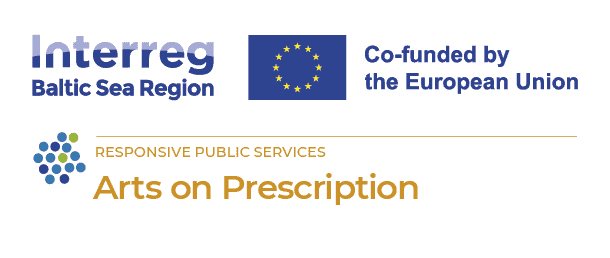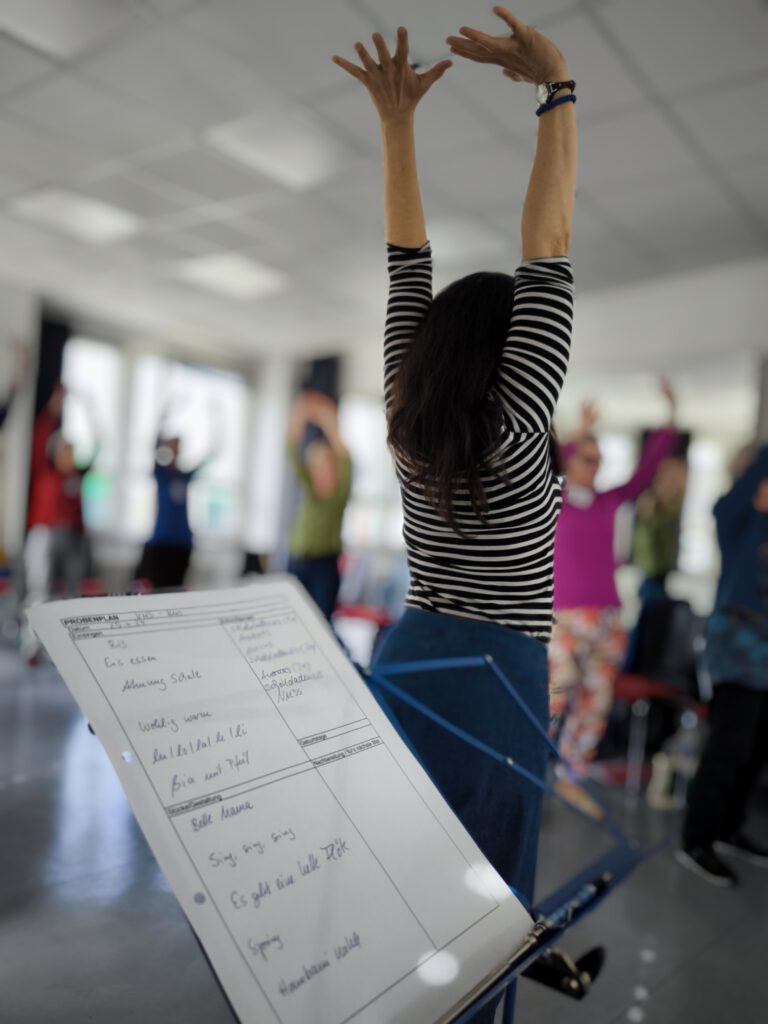
Arts on Prescription for Supporting Mental Well-Being: Co-developing a Model for the Baltic Sea Region
20 May 2025
Between 2023 and 2025, the Arts on Prescription concept has been developed, piloted and evaluated through collaboration between seven countries in the Baltic Sea region. The idea behind Arts on Prescriptions is to refer people experiencing depression, anxiety, stress, loneliness or other mild to moderate mental health challenges to take part in regular, group-based arts activities. This article* presents the group-based Arts on Prescription model developed within the Arts on Prescription in the Baltic Sea Region project and shares the experiences gathered from 24 pilot programmes.
At the beginning of 2023, thirteen partner organisations from Finland, Sweden, Denmark, Germany, Latvia, Lithuania and Poland began working together to co-develop a group-based Arts on Prescription concept. The aim was to pilot, evaluate and embed the approach during the three-year Arts on Prescription in the Baltic Sea Region project. By spring 2025, 24 pilot programmes have been organised across five countries over three pilot rounds. Sweden, Latvia and Poland each implemented six pilot groups, while Denmark and Germany organised three each. All 24 pilots have been evaluated, and the model has been refined between the pilot rounds based on the evaluation results.
What is an Arts on Prescription?
The Arts on Prescription concept and its programmes developed in the project refers to a model in which people with mild to moderate mental wellbeing challenges are referred to regular, group-based arts activities. The aim is to improve participants’ mental wellbeing and strengthen their sense of social inclusion. The Arts on Prescription model represents one form of social prescribing, an approach already well established in the United Kingdom, among other countries. The approach is grounded in evidence and understanding that participation in group-based arts activities can significantly support and enhance mental health and wellbeing.
A referral to an Arts on Prescription group may come through social and health services, voluntary organisations, or – particularly for younger participants – through schools. Once referred, the individual first meets a so-called link worker, who assesses together with them the suitability of the group for their needs. The link worker acts as the main point of contact throughout the Arts on Prescription process and provides personal support when needed. In the model developed by the project, the link worker also serves as a liaison between referral channels and the arts and culture professionals leading the activities.

Referred participants are guided to take part in regular group-based arts activities. (Photo: Ralph Seifert, vhs Bremen)
The arts activities take place in small groups. Arts on Prescription groups meet for 8–12 weeks, once or twice a week, for two to three hours at a time. During the group process, participants have the opportunity to try several art forms such as improvisation and theatre, dance, creative writing, music and visual arts. The groups may also visit museums and other cultural institutions such as theatres and opera houses. However, the focus of Arts on Prescription is not on visiting institutions but on creative participation and making art together as a group.
The sessions are led by arts and culture professionals – artists, arts educators or museum educators – who are skilled not only in their own discipline but also in facilitating groups and supporting participants. They must also be able to adapt the activities flexibly to suit each group.
Local Applications of the Arts on Prescription Model in the Baltic Sea Region
The Arts on Prescription concept has been adapted to local conditions in each participating country and city, in terms of referral mechanisms, target groups and art content.
In Sweden, in the Norrbotten region (Boden and Luleå municipalities), referrals were primarily made by rehabilitation coordinators and service coordinators in primary health care. Participants were adults of various ages. Referrals were given for reasons such as stress, anxiety, depression or prolonged sick leave. The arts activities included visual arts (often using natural materials), dance and movement, and singing.
In Poland, in the West Pomeranian region, the Arts on Prescription groups targeted young people aged 15–25. Referrals came through schools, and the programme was also promoted on social media, allowing self-referral. Activities included theatre and improvisation, dance, music and cultural visits.
In Denmark, in Odense, the model was tested with three different target groups: young adults aged 18–28, newly arrived migrants and men experiencing crisis. Referrals came from youth services, a refugee centre and a men’s crisis centre. The programmes included cultural walks, storytelling, photography, drawing and painting, as well as visits to museums and theatres.
In Latvia, in the municipality of Cēsis, a museum prescription model was piloted in collaboration with local museums. Referrals came through social centres, rehabilitation centres and employment services. In addition to guided museum tours, the activities included theatre and music workshops, as well as visual arts and creative writing sessions.
In Germany, in Bremen, a slightly different, inclusive model was tested. Instead of separate closed groups, referred participants joined existing art courses at the vhs Bremen/adult education centre (e.g. singing, creative writing, visual arts). Two to five places were reserved on each course for Arts on Prescription participants, who were referred through rehabilitation centres, general practitioners or psychotherapists. Additional joint meetings were organised for all referred participants to share experiences and reflections.
Experiences from 24 Arts on Prescription Pilots
Across the three pilot rounds, more than 250 people have taken part. Evaluation results show that the Arts on Prescription can support mental wellbeing across diverse participant groups. Participants reported various positive changes in mental wellbeing during and after the art workshops and group process. They described the activities as relaxing and calming, mood-lifting, confidence-boosting and reducing feelings of loneliness. Participation also appeared to support the development of communication, emotional and other life skills.
The positive effects seem to arise both from engaging with the arts and from the social nature of the activities. Immersion in creative work, learning something new, awakening creativity and experiencing success all play a role, as does belonging to a safe group that meets regularly and provides peer support.
Participants frequently highlighted the importance of a safe space. While all group members contribute to creating this, the facilitator plays a particularly significant role. The link worker is also crucial – ideally working alongside the artist throughout the process, allowing the facilitator to focus on leading the group while the link worker supports participants who may need special attention.
A key strength of the model developed in the project has been the diversity of art forms offered. Experiencing and engaging in art is highly individual, and participants have been able to explore and discover art forms and modes of expression that best suit them.
*Authors of the orginal Finnish article published in the online magazine Taidetutka:
Liisa Laitinen, Adviser, Arts & Health / Chief Content Officer, Arts Academy, Turku University of Applied Sciences
Outi Linnossuo, Principal Lecturer, Health and Wellbeing, Turku University of Applied Sciences
Translation in English:
Angelo Gilles, REM Consult, Communication Manager for Arts on Prescription in the Baltic Sea Region
Header image: Mask workshop in Gryfino, Poland. Photo: Marta Ciesielska
The full project’s evaluation report will be published in autumn 2025.





